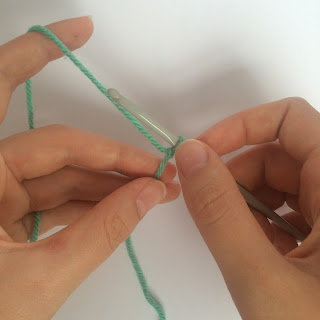The past few days I've been playing around with graph paper. I know, that sounds like SO much fun, right? Actually, yes! I'm working on some free fair isle Christmas stocking patterns I'll be releasing. I'll be posting some how-to-work-fair-isle videos to go along with those patterns on my youtube channel. It's gonna be awesome people!
QUICK NOTE: I found this super awesome resource for all you fair-isle designers out there. Over on the lovely blog Laylock Knitwear Design you can find free printable graph paper specifically designed for knitters. Instead of squares, the chart is filled with little knit stitches in perfect rows. This will give you a better idea of what the final product will look like as you're designing. Super helpful! Find the graph paper here.
Anyway, in order to put the design I created into a PDF for Ravelry, I needed to digitize my pencil-and-paper chart. Whether to have a "professional" copy of your chart for personal use or to create a download for Ravelry, you'll need to digitize it. Here's how I created my fair isle chart using Microsoft Excel 2010 on my PC:
The very first thing you'll need to do when you open Excel is alter the cells so that they're a bit more square-ish. They're fairly long rectangles by default and that won't work for us today. We need these boxes to replicate the shape of a knit stitch. So, click on the triangle in the corner (indicated by the red arrow above) to select all the cells (all the cells will turn blue), then drag the cells to 3.00 (or 26 pixels). (To drag, hover your mouse in between the "A" and "B" and a little toggle will appear. Click and hold to drag!)
Now that your cells are the size of stitches, you can begin filling them in to create your design. To do this, right click on any cell, and click the paint bucket. You can click the tiny little triangle next to the paint bucket to change the default color.
While you're in the process of designing, you can use the slider (down in the right corner) to zoom out and see how it's lookin'. :)
Once you're all done, you'll need to add some black grid lines so your chart is easy for people to read. To do this, you'll need to select your entire design by clicking the top left corner and dragging all the way down to the bottom right. Again, the cells will all turn blue.
Once you have your design selected, click the little square/window type thing in the task
bar, then select "All Borders." Boom! Chart made!
Now, in order to save
it as a picture file, you'll need to select it all again (click and drag
from corner to corner) and then copy it (by right clicking and
selecting copy).
Here's a quick tip: to see how your chart would look repeated, select your entire chart, copy it, and then paste it multiple times. Be sure to zoom out (using that toggle) to get the big picture.
How awesome is that?! Creating these charts is my new obsession. It's so satisfying to print them out and see them all nice and professional looking.
I'll talk with you guys again Friday!
Until then,
Grace










































